1994 CADILLAC ELDORADO heater
[x] Cancel search: heaterPage 98 of 398
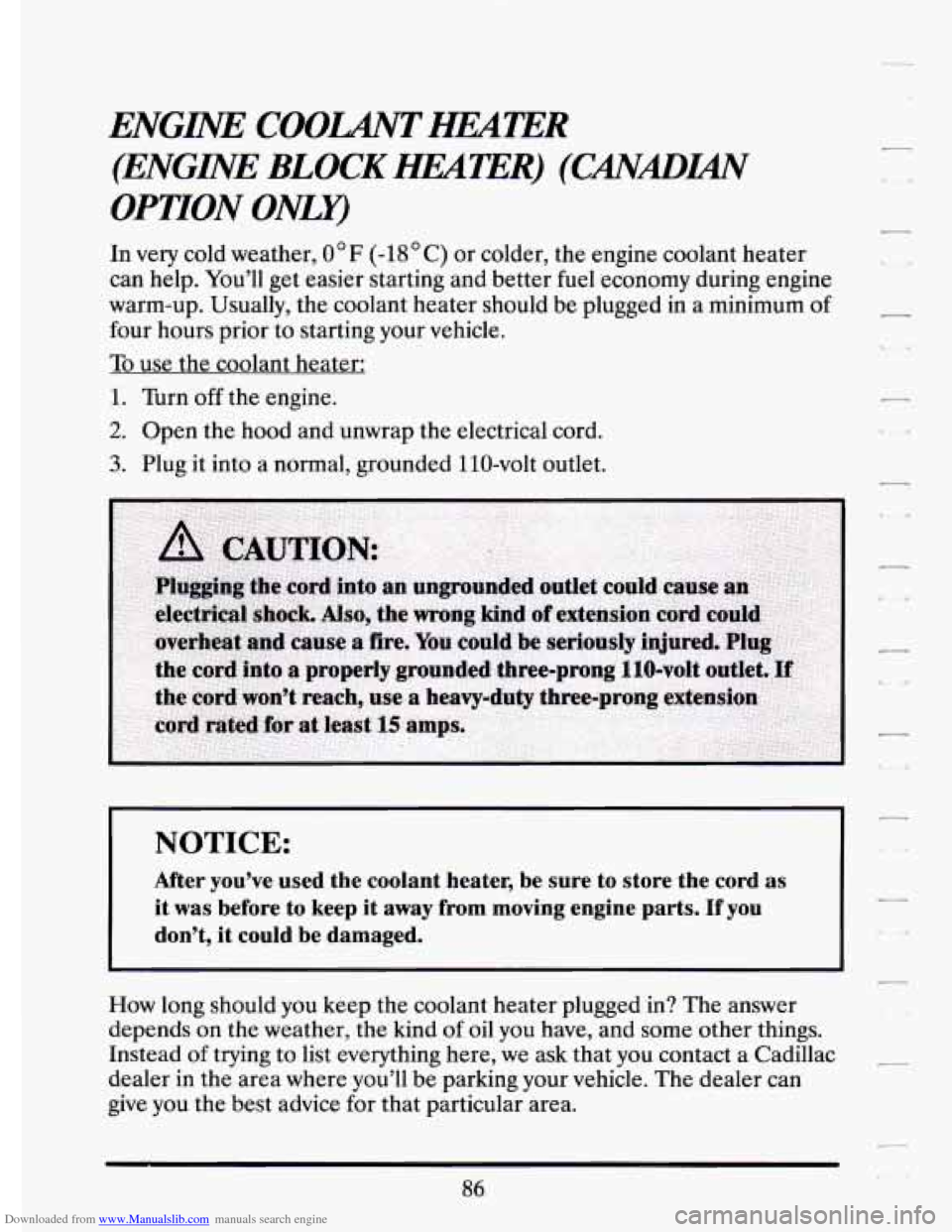
Downloaded from www.Manualslib.com manuals search engine ENGm COOLANT HMTER
(ENGW BLOCK HMTER) (CMmW
OPTION Omv
In very cold weather, 0 F (-18 C) or colder, the engine coolant heater
can help. You’ll get easier starting and better fuel economy during engine
warm-up. Usually, the coolant heater should be plugged in a minimum
of
four hours prior to starting your vehicle.
To use the coolant heater:
1. Turn off the engine.
2. Open the hood and unwrap the electrical cord.
3. Plug it into a normal, grounded 110-volt outlet.
I NOTICE:
I-
I
After you’ve used the coolant heater, be sure to store the cord as
it was before to keep it away from moving engine parts. If you
don’t, it could be damaged.
How long should you keep the coolant heater plugged in? The answer
depends
on the weather, the kind of oil you have, and some other things.
Instead
of trying to list everything here, we ask that you contact a Cadillac -
dealer in the area where you’ll be parking your vehicle. The dealer can
give you the best advice for that particular area.
Page 165 of 398
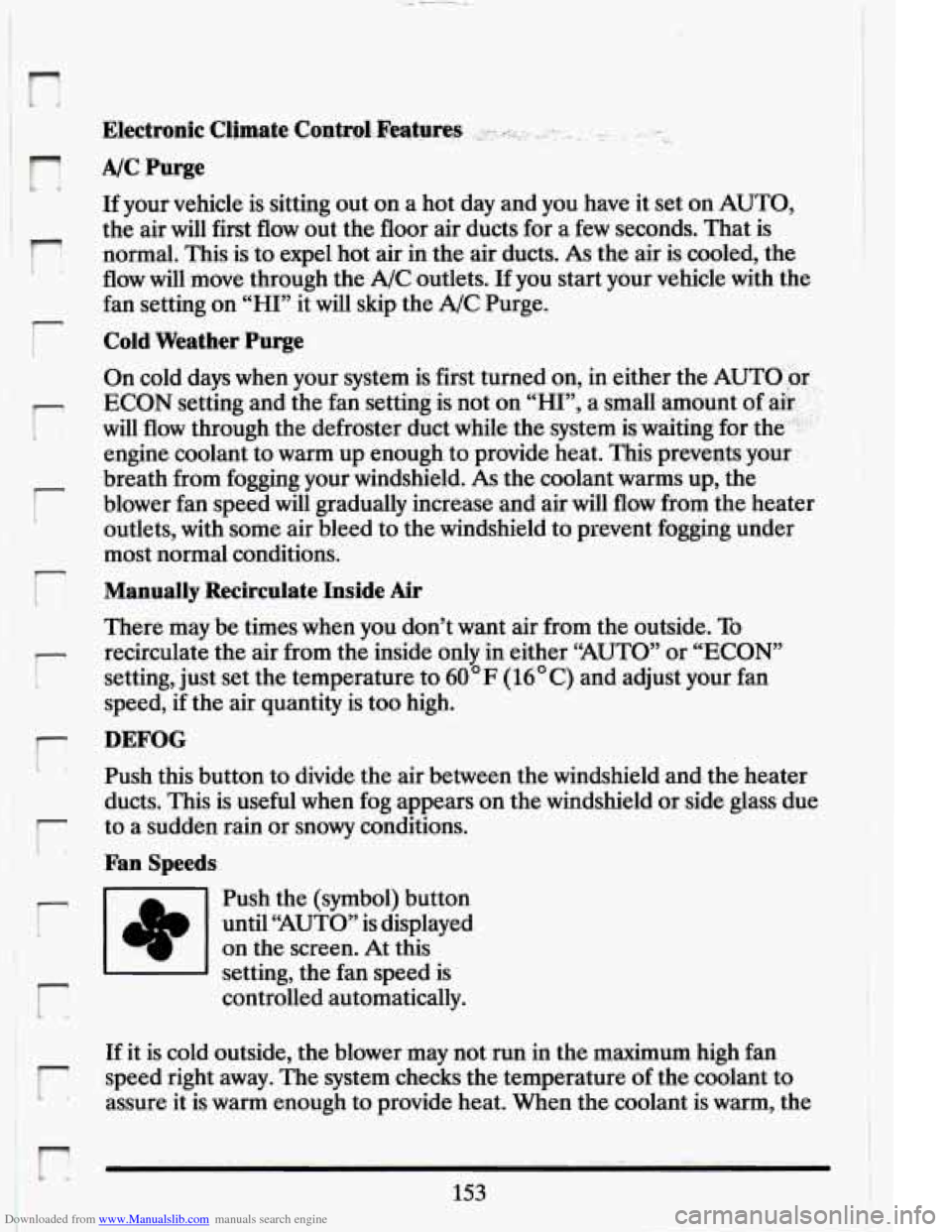
Downloaded from www.Manualslib.com manuals search engine n
ir
’r
I- t
r r
r L
r I 1
A/C Purge
If your vehicle is sitting out on a hot day and you have it set on AUTO,
the air will first flow out the floor air ducts for a few seconds. That is
normal. This is to
expel hot -air in the air ducts. As the air is cooled, the
flow will move through the A/C outlets.
If you start your vehicle with the
fan setting on “HI” it will skip the A/C Purge.
Cold Weather Purge
On cold days when your system is first turnea on, in either the AUTO’br..
ECON setting and the fan setting
is not on “HI”, a small amount of ah ::.
will flow through the defroster duct while- the system is waiting for the
engine coolant to warm up enough to provide heat. This prevents your
breath from fogging your windshield. As the coolant warms up, the
blower fan speed will gradually increase and air will flow from the heater
outlets, with some air bleed to the windshield to prevent fogging under
most normal conditions.
..
Manually Recirculate Inside Air
There may be times when you don’t want air from the outside. To
recirculate the air from the inside only in either “AUTO” or “ECON”
setting, just set the temperature to
60 F (16 C) and adjust your fan
speed, if the air quantity is too high.
DEFOG
Push this button to divide the air between the windshield and the heater
ducts.
This is useful when fog appears on the windshield or side glass due
to a sudden rain or snowy conditions.
Fan Speeds
Push the (symbol) button
until “AUTO” is displayed on the screen. At this
I 1 setting, the fan speed is
controlled automatically.
If it is cold outside, the blower may not run in the maximum high fan
speed right away. The system checksthe temperature
of the coolant to
assure it is warm enough to provide heat. When the coolant is warm, the
153
Page 212 of 398
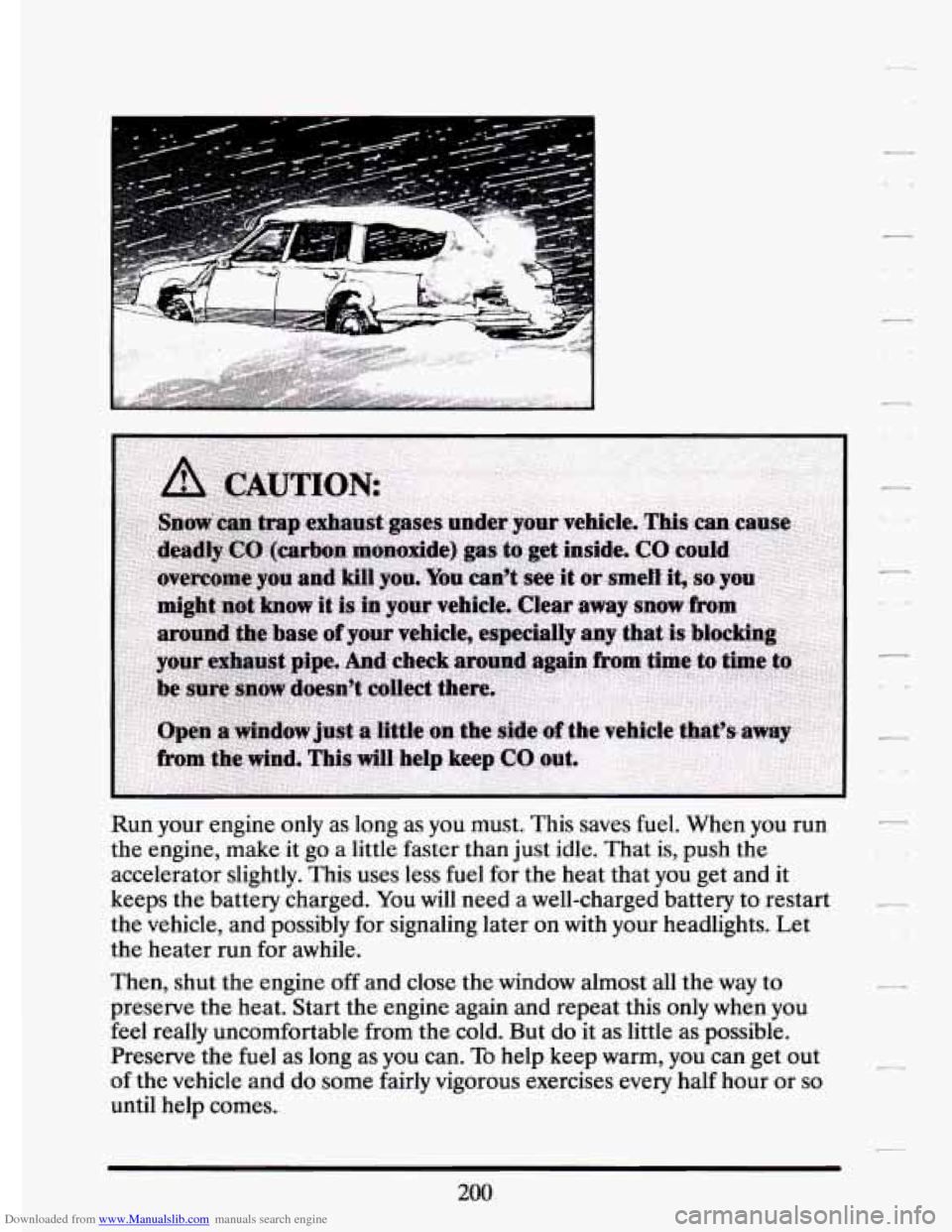
Downloaded from www.Manualslib.com manuals search engine Run your engine only as long as you must. This saves fuel. W\
hen you run
the engine, make it go a little faster than just idle. That is, push the
accelerator slightly. This uses less
fuel for the heat that you get and it
keeps the battery charged.
You will need a well-charged battery to restart
the vehicle, and possibly for signaling later
on with your headlights. Let
the heater run for awhile.
Then, shut the engine off and close the window almost all the way to
preserve the heat. Start the engine again and repeat this only when you
feel really uncomfortable from the cold. But do it as little as possible.
Preserve the fuel as long as you can. To help
keep warm, you can get out
of the vehicle and do some fairly vigorous exercises every half hour or
so
until help comes.
200
Page 234 of 398
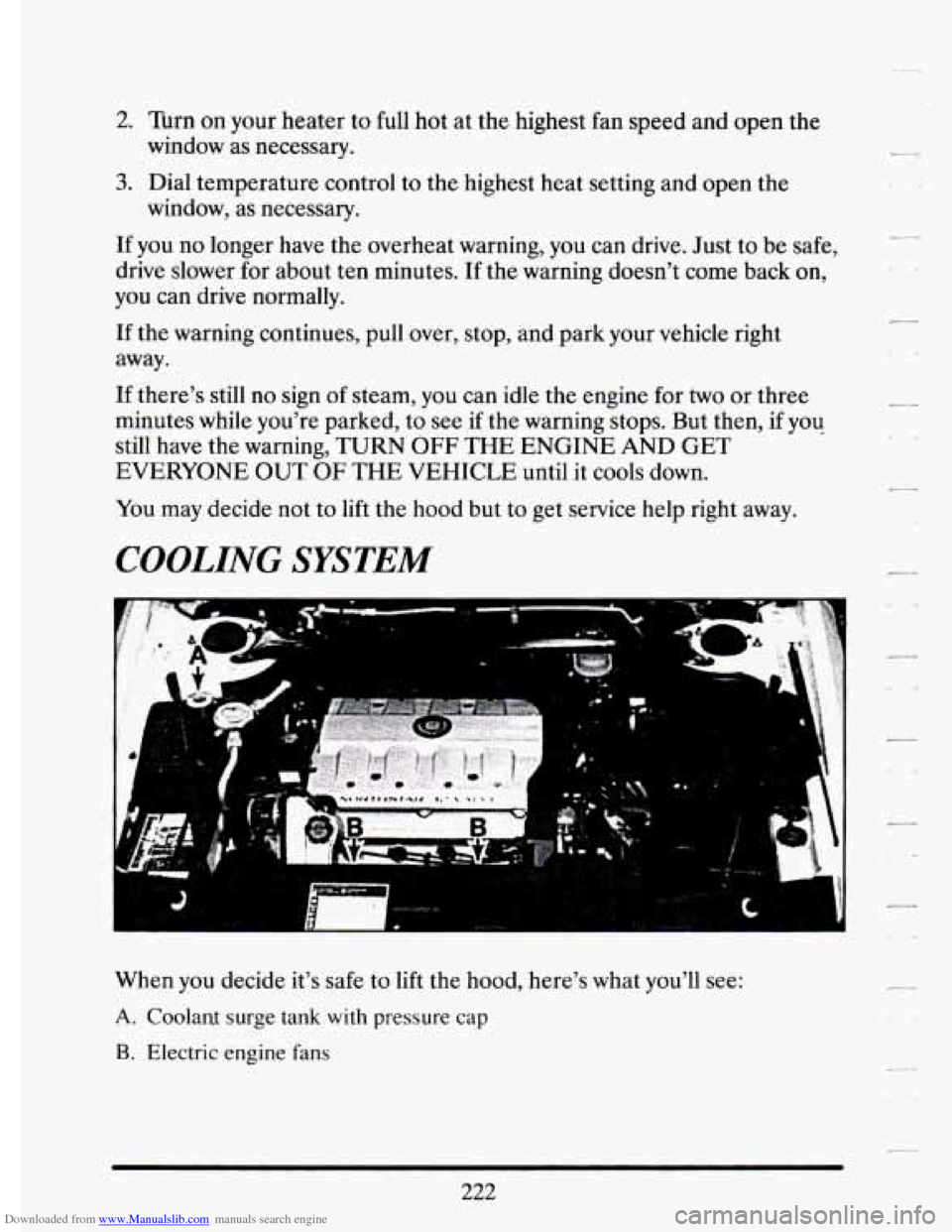
Downloaded from www.Manualslib.com manuals search engine 2. Turn on your heater to full hot at the highest fan speed and open the
window as necessary.
3. Dial temperature control to the highest heat setting and open the
window, as necessary.
If you no longer have the overheat warning, you can drive. Just to be safe,
drive slower for about ten minutes.
If the warning doesn't come back on,
you can drive normally.
If the warning continues, pull over, stop, and park your vehicle right\
away.
If there's still no sign of steam, you can idle the engine for two or three
minutes while you're parked, to see
if the warning stops. But then, if you
still have the warning, TURN
OFF THE ENGINE AND GET
EVERYONE
OUT OF THE VEHICLE until it cools down.
You may decide not to lift the hood but to get service help right away.
COOLING SYSTEM
When you decide it's safe to lift the hood, here's what you'll see:
A. Coolant surge tank with pressure cap
B. Electric engine fans
222
c-
--a
Page 236 of 398
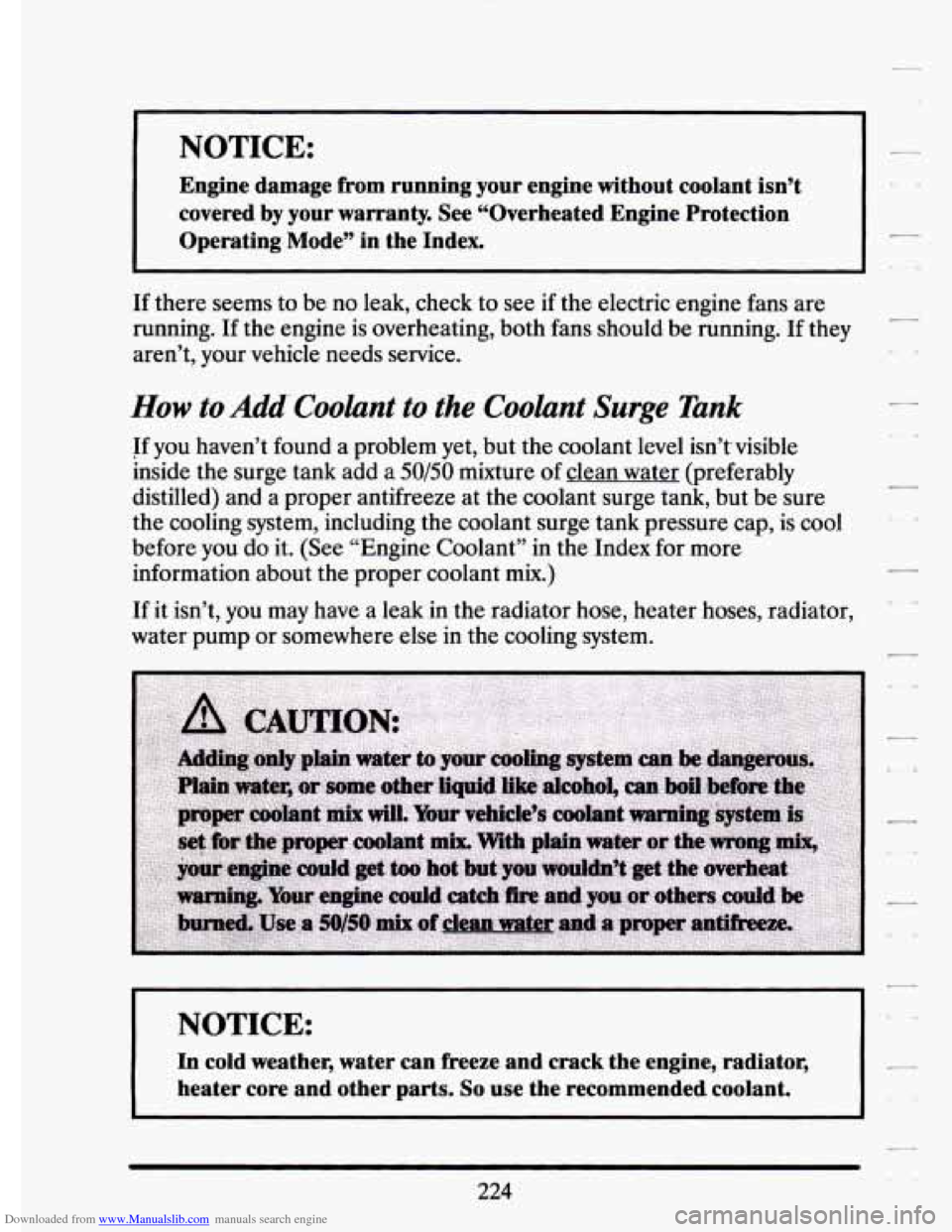
Downloaded from www.Manualslib.com manuals search engine I NOTICE:
Engine damage from running your engine without coolant isn’t \
covered
by your warranty. See “Overheated Engine Protection
Operating Mode” in the Index.
If there seems to be no leak, check to see if the electric engine fans are
running. If the engine is overheating, both fans should be running.
If they
aren’t, your vehicle needs service.
How to Add‘Coolant to the Coolant Surge Tank
If you haven’t found a problem yet, but the coolant level isn’tvisible
inside the surge tank add a
50/50 mixture of clean water (preferably
distilled) and a proper antifreeze at the coolant surge tank, but be sure
the cooling system, including the coolant surge tank pressure cap, is
cool
before you do it. (See “Engine Coolant’’ in the Index for more
information about the proper coolant mix.)
If it isn’t, you may have a leak in the radiator hose, heater hoses, radiator,
water pump or somewhere else in the cooling system.
c
NOTICE:
I
In cold weather, water can freeze and crack the engine, radiat\
or, -
heater core and other parts. So use the recommended coolant. L
_I
224
Page 269 of 398
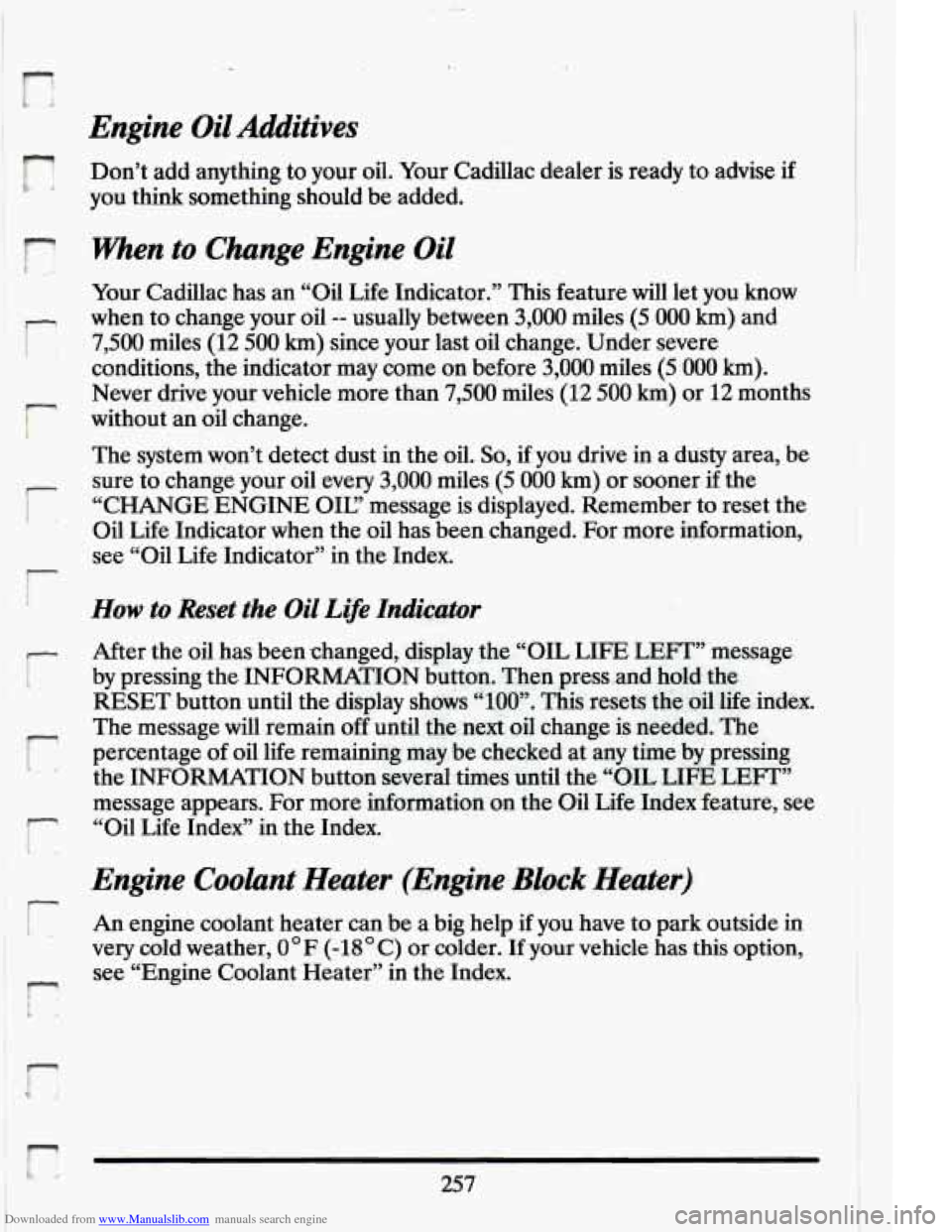
Downloaded from www.Manualslib.com manuals search engine Engine Oil Additives
k Don’t add anything to your oil. Your Cadillac dealer is ready to advise if
you think something should be added.
‘C When to Change Engine Oil
r
r
3 r
r
r
r
Your Cadillac has an “Oil Life Indicator.” This feature will let you know
when to change your oil
-- usually between 3,000 miles (5 000 km) and
7,500 miles (12 500
km) since your last oil change. Under severe
conditions, the indicator may come on before
3,000 miles (5 000 km).
Never drive your vehicle more than 7,500 miles (12 500 km) or 12 months
without an oil change.
The system won’t detect dust in the oil.
So, if you drive in a dusty area, be
sure to change your oil every 3,000 miles (5 000 km) or sooner if the
“CHANGE ENGINE OK’ message is displayed. Remember to reset the
Oil Life Indicator when the oil has been changed. For more information,
see “Oil Life Indicator” in the Index.
How to Reset the Oil Life Indicator
r
After the oil has been changed, display the “OIL LIFE LEFT” message
by pressing the INFORMATION button. Then press and hold the
RESET button until the display shows
“loo”.. This resets thle.,oil life index.
The message will remain
off until the next oil change is needed. The
percentage of oil life remaining may be checked at any time by pressing
the INFORMATION button several times until the
“OIL LE% LEFT”
message appears. For more information on the Oil Life Index feature, see
“Oil Life Index” in the Index.
Engine Coolant Heater (Engine Block Heater)
An engine coolant heater can be a big help if you have to park outside in
very cold weather, O°F (-18O C) or colder. If your vehicle has this option,
see “Engine Coolant Heater” in the Index.
257
Page 276 of 398
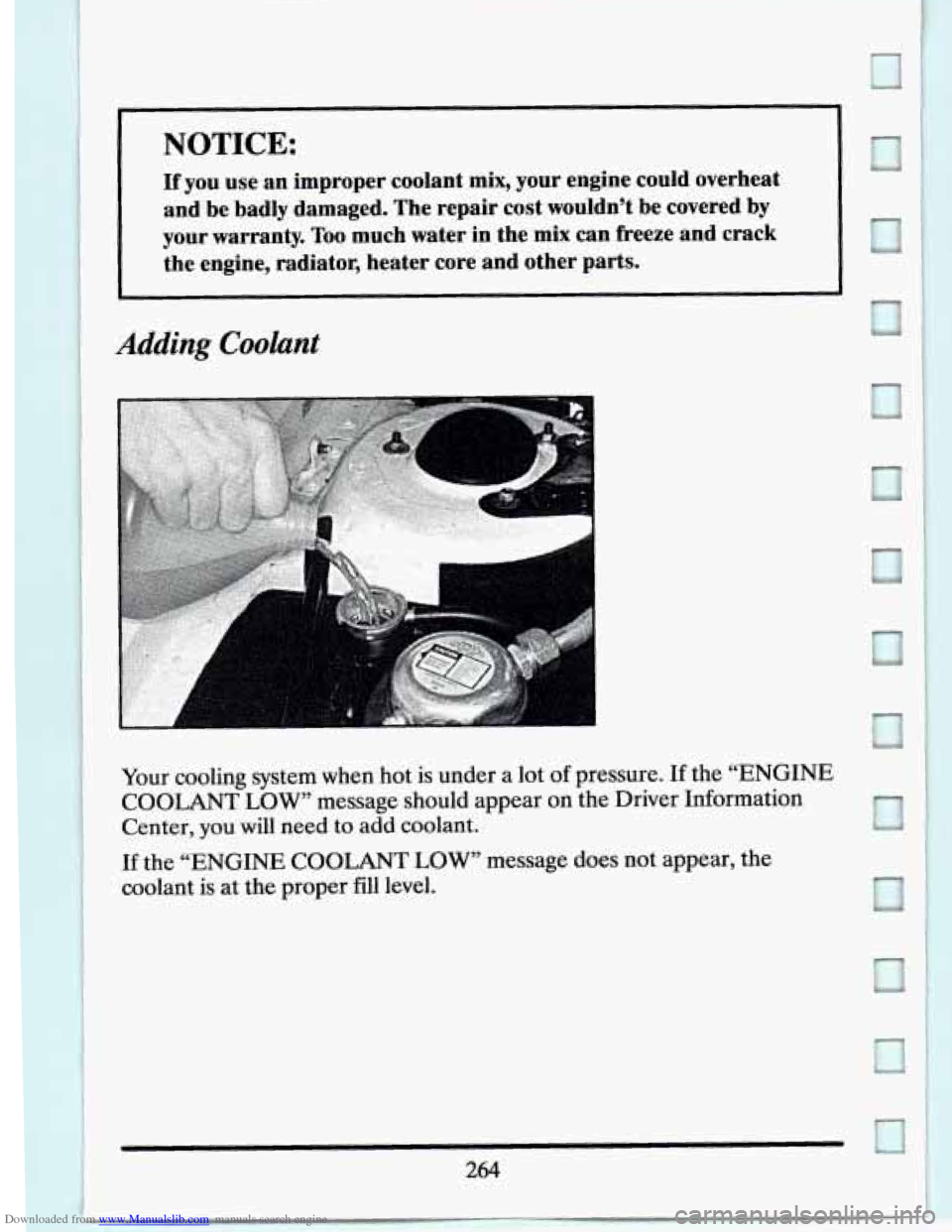
Downloaded from www.Manualslib.com manuals search engine NOTICE:
If you use an improper coolant mix, your engine could overhea,t
and be badly damaged. The repair cost wouldn’t be covered b\
y
your warranty. Too much water in the mix can freeze and crack
the engine, radiator, heater core and other parts.
Adding Coolant
I
Your cooling system when hot is under a lot of pressure. If the “ENGINE
COOLANT
LOW” message should appear on the Driver Information
Center,
you will need to add coolant.
If the “ENGINE COOLANT LOW” message does not appear, the
coolant is at the proper fill level.
Ll
264
Page 325 of 398

Downloaded from www.Manualslib.com manuals search engine Y
r
r I
i
r
!r:
i E
,r
i 'E
L HDLP LO R HDLP LO L HDLP HI R HDLP HI ION 3 COOL'FAN TRANS
I FUSE CENTER IDENTIFICATION I
ENGINE COMPARTMENT FUSE BLOCK
DlSTR 20A
SIR 20A - IGNITION CONTROL MODULE
- DIAGNOSTIC/ENERGY RESERVE
MODULE (DERM)
- DUAL POLE ARMING SENSOR PCM (ION 1OA
- PASS-Key@ DECODER MODULE INJ 10A
- POWERTRAIN CONTROL MODULE (PCM)
- 1,4,6, AND 7 FUEL INJECTORS
- 2.3.5. AND 8 FUEL INJECTORS INJ 1OA
ION
1 iOA - A/C REFRIGERANT PRESSURE SWITCH - TRANSAXLE RANGE SWITCH - STOP/BTSI/CRUISE BRAKE SWITCH - INSTRUMENT PANEL'CLUSTER - KEYLESS ENTRY MODULE - DIAGNOSTlCfENERGY RESERVE MODULE
- PERM2 ORN RING LIGHTS - TURN/HAZARD SWITCH ASSY. - CHIME MODULE - HEADLIGHT SWITCH - TWILIGHT SENTINEUDRL MODULE
- FUELPUMP - OIL PRESSURE SWITCH - POWERTRAIN CONTROL MODULE IPCMI
FUEL PUMP 20A
PCM (BAT) 1OA
RTD
, AT) 20A - RgAD SENSING SUSPENSION (RSS) MODUL A/C COMP 1OA
- POWERTRAIN CONTROL MODULE (PCM)
- A/C COMPRESSOR CLUTCH HDLPS 3OA
.~
- HEADLIGHT DIMMER SWITCH - HEADLIGHT RELAY "D (ENGINE COMF!
- DRL HEADLIGHT RELAY "E" (WITH DAYTIME
- POWERS C13 MICRO RELAY CENTER)
RUNNING LIGHTS)
E
STOP LP 2OA - STOP/BTSI/CRUISE SWITCH - STOPUGHT SWITCH CAPACITOR TURNIHAZ 20A - HAZARD FLASHER - TURN FLASHER RELAY - TURN FLASHER MODULE DRL 1 OA (CANADA) - DAV~ME RUNNI'NG LIGHTS (CANADA) ~ ~~
DRL 1 OA (CANADA)
HTD
W/S 1OA
L HDLP LO 1OA
- LEFT AND RIGHT LO BEAM HEADLAMP
- HEATED WINDSHIELD CONTROL MODULE
- LEFT LO BEAM HEADLAMP R HDLP LO 10A
L HDLP HI 1OA - RIGHT LO BEAM HEADLAMP
- LEFT HI BEAM HEADLAMP R HDLP HI 1OA
IGN
3 10A - RIGHT HI BEAM HEADLAMP
- REAR DEFOGGERRELAY - ELECTRONIC LEVEL CONTROL IELCI - HEATED WINDSHIELD - HEATER AND A/C PROGRAMMER - CRUISE CONTROL
..
COOLING FAN 1OA - MENDED TRAVEL BRAKE SWITCH - POWERTRAIN CONTROL MO'DULE (PCM) - COOLING FAN RELAYS 1,2, AND 3 - FRONT AND REAR HEATED OXYGEN SENSOR TRANSIECS 1 OA - OVERSPEED ALERT MODULE (=PORT) - POWER STEERING PRESSURE SWITCH - EXHAUST GAS REClRCULAilON (EGR) VALVE - TRANSAXLE SHIFT SOLENOIDS A & B - EVAPORATIVE EMISSION CONTROL
SOLENOID ~~
- POWERTRAIN CONTROL MODULE (PCM) - TORQUE CONVERTER CLUTCH SOLENOID - TCC BRAKESWlTCH
313